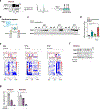Epigenetic Derepression of PROX1 Promotes Neuroendocrine Prostate Cancer Progression
- PMID: 40838977
- PMCID: PMC12492970
- DOI: 10.1158/0008-5472.CAN-25-0636
Epigenetic Derepression of PROX1 Promotes Neuroendocrine Prostate Cancer Progression
Abstract
Histologic transformation of prostate cancer from adenocarcinoma to neuroendocrine prostate cancer (NEPC) is associated with aggressive disease and poor prognosis. This lineage transition is accompanied by polycomb complex 2-mediated epigenetic derepression of cell fate-determining transcription factors, including prospero homeobox 1 (PROX1). In this study, we sought to functionally characterize the role of PROX1 in NEPC. An unbiased CRISPR screen in two NEPC patient-derived organoid models demonstrated high cellular dependency for PROX1. Knockout of PROX1 impeded tumor growth in NEPC models, and overexpression of PROX1 promoted tumor growth and spontaneous metastasis in prostate adenocarcinoma. Transcriptomic and cistromic analyses across castration-resistant adenocarcinoma and neuroendocrine models pointed to PROX1-mediated regulation of neuroendocrine-lineage transcriptional programs. Immunoprecipitation followed by mass spectrometry identified three phosphorylated sites in the DNA-binding domain of PROX1 that are critical for its stability and function. CHEK1 and CDK2 were predicted to be upstream kinases that phosphorylate PROX1, and treatment with a CHEK1 or CDK2 inhibitor reduced NEPC viability. Together, these results substantiate the role of PROX1 in NEPC and identify PROX1 phosphorylation in the DNA-binding domain, which might represent a therapeutic target in NEPC.
Significance: PROX1 mediates lineage reprogramming, tumor growth, and metastasis in neuroendocrine prostate cancer and represents a cellular dependency that can be exploited for targeted treatment strategies.
©2025 American Association for Cancer Research.
Conflict of interest statement
Declaration of Interests
H.B. has served as consultant/advisory board member for Janssen, Astra Zeneca, Merck, Pfizer, Amgen, Bayer, Novartis, Daiichi Sankyo, and has received research funding (to institution) from Janssen, Bristol Myers Squibb, Circle Pharma, Daiichi Sankyo, Novartis. F.V. receives research support from the Dependency Map Consortium, Riva Therapeutics, Bristol Myers Squibb, Merck, Illumina, and Deerfield Management. F.V. is on the scientific advisory board of GSK, is a consultant and holds equity in Riva Therapeutics and is a co-founder and holds equity in Jumble Therapeutics.
Figures




References
-
- Hanahan D Hallmarks of Cancer: New Dimensions. Cancer discovery 2022; 12: 31–46. - PubMed
-
- Siegel RL, Miller KD, Wagle NS, Jemal A Cancer statistics, 2023. CA Cancer J Clin 2023; 73: 17–48. - PubMed
-
- Huggins C, Hodges CV Studies on prostatic cancer. I. The effect of castration, of estrogen and androgen injection on serum phosphatases in metastatic carcinoma of the prostate. CA Cancer J Clin 1972; 22: 232–240. - PubMed
MeSH terms
Substances
Grants and funding
- P50 CA090381/CA/NCI NIH HHS/United States
- P50 CA272390/CA/NCI NIH HHS/United States
- R25 CA221738/CA/NCI NIH HHS/United States
- R37 CA241486/CA/NCI NIH HHS/United States
- P50 CA211024/CA/NCI NIH HHS/United States
- P30 CA006516/CA/NCI NIH HHS/United States
- P50 CA211024-01A1/National Cancer Institute (NCI)
- R37CA241486-01A1/National Cancer Institute (NCI)
- P50 CA272390-01/National Cancer Institute (NCI)
- W81XWH2210197/U.S. Department of Defense (DOD)
- National Cancer Center (NCC)
- 23YOUN15/Prostate Cancer Foundation (PCF)
- R25CA221738/National Cancer Institute (NCI)
- Prostate Cancer Foundation (PCF)
- W81XWH-17-1-0653/U.S. Department of Defense (DOD)
LinkOut - more resources
Full Text Sources
Medical
Research Materials
Miscellaneous

